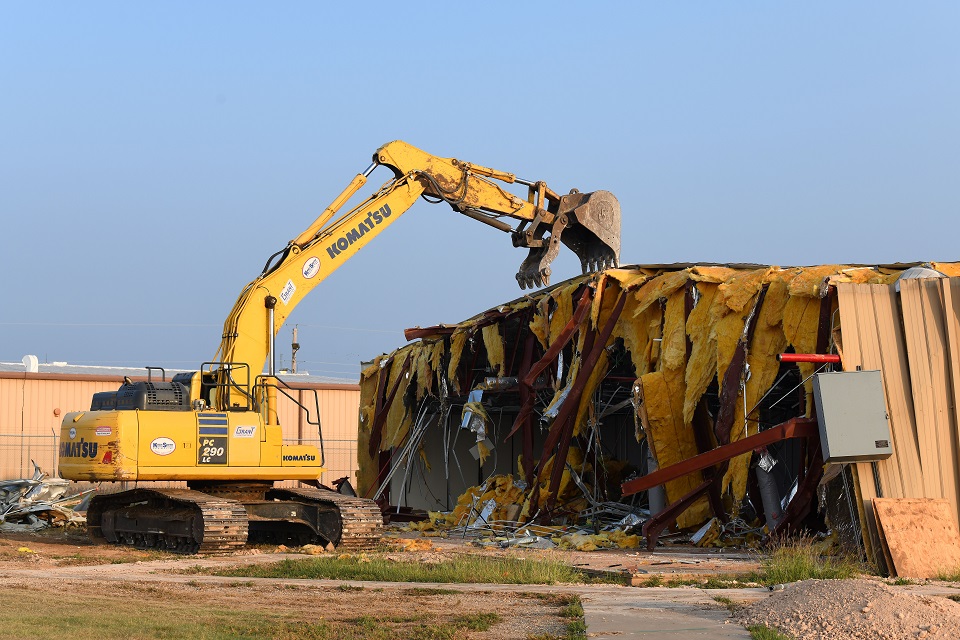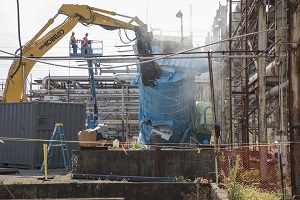
Crews demolished Pantex Buildings 12-106 and 12-106A in FY 2020 as part of the disposition plan enabled by the opening of the John C. Drummond Center. EFDP characterized the facilities, removed waste, demolished the structures, and disposed of all demolition debris.
You’ve probably seen or heard about the ongoing demolition of Y-12’s old Biology Complex. It’s a major project that will clear space for construction of the Lithium Processing Facility. But massive, headline grabbing projects like this only tell part of the demolition story at Pantex and Y-12.
Across our sites, a team of employees and subcontractors — working with the National Nuclear Security Administration (NNSA) Production Office (NPO) and NNSA’s Office of Safety, Infrastructure, and Operations (NA 50) — has been quietly dispositioning legacy facilities for the past five years. In fact, since 2015, NNSA’s Disposition Program has removed more than 100 Pantex and Y-12 facilities.
“For several years, we’ve been strategically removing legacy equipment and materials, packing and shipping contaminated waste, and demolishing facility structures,” said Diane McDaniel, senior director, Excess Facilities Transformation, noting that disposition means far more than just demolition.
It’s high complexity, high consequence work. Most of the facilities were dangerously degraded and contained industrial hazards such as mercury, asbestos, and beryllium. And if that didn’t make things hard enough, the majority were located inside the sites’ protected areas, in close proximity to occupied facilities running essential mission operations.
Yet, from 2015 to 2020, the team dispositioned nearly 110 facilities — some 40 at Pantex and 70 at Y-12 — without a single safety or security incident, release of hazardous material to the environment, or impact to mission deliverables.
“I’m so proud of this team for the work they’ve done,” McDaniel said. “This program is such an important part of our sites’ commitment to legacy risk reduction and site modernization.”
With each completed disposition project, the team is reducing both the risks inherent in excess facilities and the costs associated with maintaining them. The Legacy Facilities and Services Team regularly dons personal protective equipment just to walk down these excess facilities, assess conditions, and mitigate any potential hazards

Crews demolish a Building 9201-05 (Alpha 5) dust collector tower at Y-12. Removal of this process contaminated facility eliminated the risk of facility degradation and/or fire and associated contamination release. This project furthered the preparation of Alpha 5 for demolition by EM.
Despite the challenges, the Projects Management team that executes facility dispositions has consistently met its milestones — even in 2020, with its period of reduced site operations and quarantines.
“The big thing last year was adapting. If one project couldn’t move forward due to COVID-19 impacts, weather, or site conditions, we were able to quickly substitute another,” said Kim Irwin, senior director of Projects Management. “Thanks to program managers, project managers, work planners, subcontractor partners, and our NNSA customers, we had the agility to adjust our plans to keep the teams together and maintain our momentum.”
All told, the program has reduced the excess facility footprint at Pantex and Y-12 by nearly 250,000 square feet to date, an amount comparable to the largest facility in the Biology Complex. But the program’s true impact may not be realized for years.
“Collectively, these 100 plus facility dispositions are addressing our sites’ 75 year legacies; reducing risk and improving safety today; and clearing the way for future projects and operations,” said Y-12 managing and operating contractor Consolidated Nuclear Security’s (CNS) Chief Operating Officer Bill Tindal. “This demonstrated partnership among NNSA, NPO, CNS, and the subcontracting community is key in transforming our sites into agile, responsive national assets for the next 75 years.”